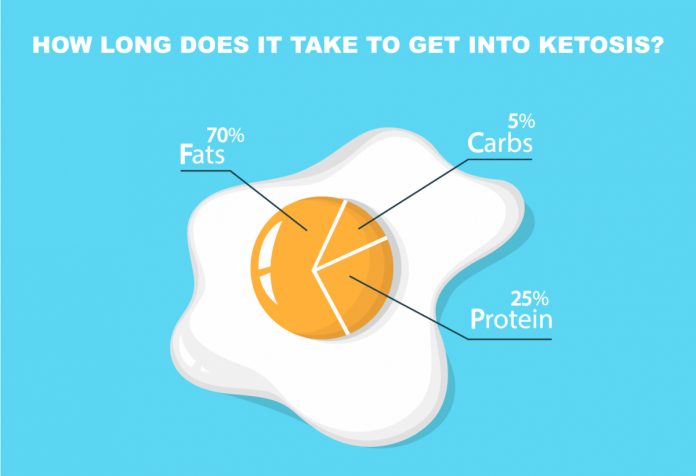Next let’s jump into the ketogenic diet, or “keto” for short. This is a low-carb, high fat diet. It’s even been proven to positively help prevent and control onset of many chronic lifestyle & age-related diseases including diabetes, cancer, epilepsy and Alzheimer’s. The main “switch” that’s happening with this diet is the substitution of most of your carbs in favor of healthy whole fats. This exchange puts your body into what is called metabolic ketosis, a state where you are burning stores of actual body fat rather than just burning sugar for fuel and energy. There are four different keto diets, all listed below, that you can choose from based on your specific lifestyle or goals:
- Standard ketogenic diet (SKD): This is a very low-carb, moderate-protein and high-fat diet. It typically contains 75% fat, 20% protein and only 5% carbs.
- Cyclical ketogenic diet (CKD): This diet involves periods of higher-carb refeeds, such as 5 ketogenic days followed by 2 high-carb days.
- Targeted ketogenic diet (TKD): This diet allows you to add carbs around workouts.
- High-protein ketogenic diet: This is similar to a standard ketogenic diet, but includes more protein. The ratio is often 60% fat, 35% protein and 5% carbs.
These days, the ketogenic diet is one of the preferred and recommended diets by health professionals for disease prevention and weight loss. In terms of diabetes prevention specifically, the fat loss you experience on the ketogenic diet will help reverse symptoms of metabolic syndrome often linked with the disease. There have been numerous studies documenting successful results in disease reversal, even including people who have been able to stop using their diabetes medication completely after switching to the ketogenic diet. Just as with the paleo diet above, the list of things to avoid, courtesy of healthline.com, is below. You will notice several similarities and a few differences from the paleo diet:
- Sugary foods: Soda, fruit juice, smoothies, cake, ice cream, candy, etc.
- Grains or starches: Wheat-based products, rice, pasta, cereal, etc.
- Fruit: All fruit, except small portions of berries like strawberries.
- Beans or legumes: Peas, kidney beans, lentils, chickpeas, etc.
- Root vegetables and tubers: Potatoes, sweet potatoes, carrots, parsnips, etc.
- Low-fat or diet products: These are highly processed and often high in carbs.
- Some condiments or sauces: These often contain sugar and unhealthy fat.
- Unhealthy fats: Limit your intake of processed vegetable oils, mayonnaise, etc.
- Alcohol: Due to their carb content, many alcoholic beverages can throw you out of ketosis.
- Sugar-free diet foods: These are often high in sugar alcohols, which can affect ketone levels in some cases. These foods also tend to be highly processed.
Foods you should be focused on include:
- Meat: Red meat, steak, ham, sausage, bacon, chicken and turkey.
- Fatty fish: Such as salmon, trout, tuna and mackerel.
- Eggs: Look for pastured or omega-3 whole eggs.
- Butter and cream: Look for grass-fed when possible.
- Cheese: Unprocessed cheese (cheddar, goat, cream, blue or mozzarella).
- Nuts and seeds: Almonds, walnuts, flax seeds, pumpkin seeds, chia seeds, etc.
- Healthy oils: Primarily extra virgin olive oil, coconut oil and avocado oil.
- Avocados: Whole avocados or freshly made guacamole.
- Low-carb veggies: Most green veggies, tomatoes, onions, peppers, etc.
- Condiments: You can use salt, pepper and various healthy herbs and spices.
And here is another sample menu to get you started:
Monday
- Breakfast: Bacon, eggs and tomatoes.
- Lunch: Chicken salad with olive oil and feta cheese.
- Dinner: Salmon with asparagus cooked in butter.
Tuesday
- Breakfast: Egg, tomato, basil and goat cheese omelet.
- Lunch: Almond milk, peanut butter, cocoa powder and stevia milkshake.
- Dinner: Meatballs, cheddar cheese and vegetables.
Wednesday
- Breakfast: A ketogenic milkshake.
- Lunch: Shrimp salad with olive oil and avocado.
- Dinner: Pork chops with Parmesan cheese, broccoli and salad.
Thursday
- Breakfast: Omelet with avocado, salsa, peppers, onion and spices.
- Lunch: A handful of nuts and celery sticks with guacamole and salsa.
- Dinner: Chicken stuffed with pesto and cream cheese, along with vegetables.
Friday
- Breakfast: Sugar-free yogurt with peanut butter, cocoa powder and stevia.
- Lunch: Beef stir-fry cooked in coconut oil with vegetables.
- Dinner: Bun-less burger with bacon, egg and cheese.
Saturday
- Breakfast: Ham and cheese omelet with vegetables.
- Lunch: Ham and cheese slices with nuts.
- Dinner: White fish, egg and spinach cooked in coconut oil.
Sunday
- Breakfast: Fried eggs with bacon and mushrooms.
- Lunch: Burger with salsa, cheese and guacamole.
- Dinner: Steak and eggs with a side salad.
And as a bonus here are some additional keto snacks you can go with to satisfy any cravings:
- Fatty meat or fish
- Cheese
- A handful of nuts or seeds
- Cheese with olives
- 1–2 hard-boiled eggs
- 90% dark chocolate
- A low-carb milkshake with almond milk, cocoa powder and nut butter
- Full-fat yogurt mixed with nut butter and cocoa powder
- Strawberries and cream
- Celery with salsa and guacamole
- Smaller portions of leftover meals [1]
I hope this has been an informative read for everyone. Remember, stick to your guns and I guarantee you will love your results! Also, remember that even with these diets you should still deviate from time to time. This will help you stay sane and motivated. I don’t mean go out and eat a stack of pancakes dripping with sugary syrup every Saturday for brunch or have 6 beers in one sitting, I mean that you should stick to a diet for about 4-5 months, then come off it for a few weeks, eat carbs, introduce back some variety even though it may not be as healthy, and then after about two weeks off, start back up again on the diet. My personal routine is going paleo for about 3 months out of the year and sticking to a keto diet the rest of the time. My main cheat periods are vacations (no sense going to Italy if you can’t enjoy the cheesy pasta, right?!) and holidays such as Christmas and Thanksgiving (let’s face it, we all need to let go a little bit and have the apple pecan pie for dessert after a nice roasted ham with cherries on top!) And check out healthline.com for more details on these and other health protocols!
Until next time, biohackers…
SOURCES










